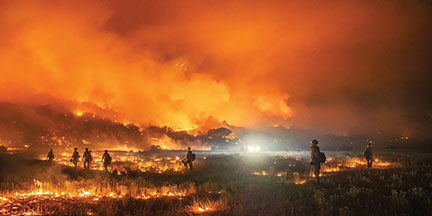“He could feel the hair on the back of his neck burning as he was speeding out of town to run from the fires,” upper school grandparent and Hawaii resident Joseph Pelletier said. “Waylon, one of my close work friends, was right in the fires when they started. He got on his Harley motorcycle and took off, going 70 mph towards Kaanapali. He had never seen so much fear and terror up close in his life.”
Around 6:35 a.m. on Aug. 8, a brush fire ignited near a fallen power which had fallen in high winds, leading to a wildfire across the residential areas of Lahaina.
An estimated 40 people climbed over the harbor’s seawall and jumped into the ocean, treading water for hours amidst the smoke and haze while clutching to their families.
The seas, once known as a calming presence in Lahaina, became a place of panic and refuge amidst the terror.
The wildfire killed 115 people, destroyed over 2,000 homes, and affected 800 businesses within the burn area.
Three months later, the Maui community is left in the ash with a long recovery ahead from the worst natural disaster in Hawaii’s history.
“Since childhood, I have spent a lot of time in Lahaina. It was a bit of a second home to me as my father had a place there since the ‘70s. We spent some holidays with a local family we were close with. I watched Lahaina change over the decades, but it always retained its soulfulness and one-of-a-kind nature,” said Upper School parent Stacie Hirsch.
“The landmarks never changed. You could always count on the talking bird inside the Pioneer Inn restaurant to greet you. My kids ran around the Banyan tree the same as I did when I was young. I loved the sounds the old wooden sidewalks would make when you walked over them. I developed a lot of sense memories from a very young age and felt very lucky that I got to share Lahaina with my kids as well.”
When Stacie first heard the news of the fire, it was a shock.
“I felt heartbroken. Seeing the images of the beloved town in its current state was hard even to process, and in each of the stories I read of loss and survival, every new detail was inconceivable. The images also reminded me of the mudslide we experienced here in our town, which looked like a war zone as well, so that memory bubbled up too,” Stacie said.
The loss of Lahaina came as a shock to everyone.
“When I looked it up, I saw how ravaged the town was, and the banyan tree was gone; all these buildings and homes were gone,” junior Jules Leclercq said. “I was pretty blown away. I didn’t believe it when I heard about it from my mom and my friends, but when I saw the photos, it sank in.”
Everyone living in Hawaii, no matter the island, was greatly affected by the chaos of those tragic days and those following it. “I had so many amazing memories in that town. I never imagined one day the whole thing would be ashes,” Pelletier said. “[After the fire], people brought water and canned goods down to the harbor from the bigger islands to put it on boats to get all of it to Lahaina. There was eventually an overwhelming amount of canned goods and water that everyone just started asking for money so they could start funding other things, like rebuilding.”
A pressing issue facing Maui residents is the future of their land and whether it will even remain theirs.
There are threats of rebuilding Lahaina in a way that does not prioritize the needs of the residents: merely days after the fire, developers swooped in with offers to buy burned land from survivors whose homes were damaged or destroyed.
The strain on available housing causes desperation, but it’s crucial for the well-being of the residents and places for them to live and rebuild.
The old town of Lahaina is gone but not forgotten.
“I visited Maui toward the beginning of the summer, late June and early July, and stayed on the south-shore,” said Jules. “My most memorable experience in Lahaina was going to the big [banyan] tree. I had been there when I was a kid, five or six years ago, and I remembered the tree, so it was cool to see it again. It’s so sad that it’s gone now.”
The famous Ficus Benghalensis, or banyan fig tree, in front of the local courthouse, was planted in 1873 by the town’s sheriff.
It began as an eight-foot sapling rooted in the volcanic soil as a symbol of community. It is known famously as the largest tree in Hawaii, whose deep roots held a symbolic presence as a beloved park for both locals and tourists alike, standing over 60 feet in the air.
The scorched tree now shows signs of revival, as baby sprouts of green pop up amongst the charred bark.
Locals water the roots with the hope of rebuilding bits and pieces of Lahaina slowly and with care from everyone.
“The fires affected many local artists, too. One of my good friends, who was a local artist, had his entire shop burn down with all of his life works inside. After he had lost everything, he decided the business was going to be too hard to rebuild and decided to shut down and move back to New York,” Pelletier said. “Some of the hardest parts now is seeing the families go back into the houses and finding nothing but ash where their beautiful homes used to stand.”
There are ways to support Maui’s recovery.
One way to effectively help is through funding, to give locals resources they need while they assess their living situations, and to provide means for businesses and such to re-open.
“The Hawaii Community Foundation Maui Strong Fund is a good way to support,” Hirsch said.
“My friend Kristina McKean, who owns The Elephant Project in Santa Barbara, donated net proceeds of the month of the fires to the Maui Humane Society to help animals affected.”
A debate on whether tourism in Maui should begin or be halted out of respect for locals continues.
In the early stages of recovery, residents begged tourists to stay away from Maui as the priority was to find hotel rooms and Airbnbs for those who lost their homes.
However, the economy is stalled without tourists supporting local businesses.
The Hawaii Tourism Authority encourages travel to Maui but asks visitors to avoid the western areas of the island, including Lahaina.
“I wonder what it’s going to be like in the future. I wonder if they are going to rebuild Lahaina the same way it was before or if they’re going to rebuild it and make it a whole new town,” Jules said.

Photo by Rebecca Hernandez (CC0 1.0)Daphne Shiebler













